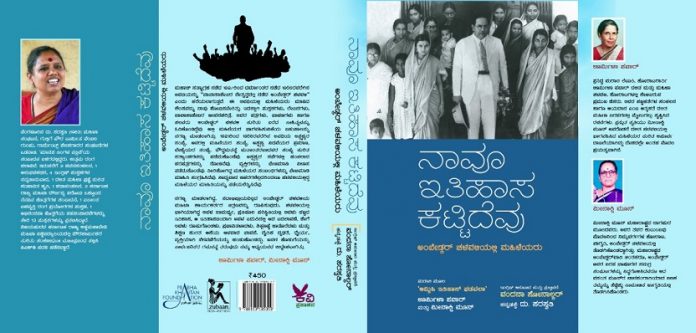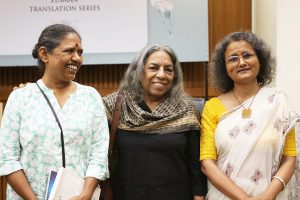
Kannada writer, translator and activist D Saraswathi speaks with Indian Printer and Publisher’s Priyanka Tanwar about her association with the Zubaan-Prabha Khaitan Foundation Translation Series. She discusses Kannada translation – and its challenges, taking the work to international audiences, and the rising demand for literature translated into vernacular languages.
Indian Printer & Publisher (IPP) – How did you become a translator and how long have you been one?
D Saraswathi – I started translating around 1985. I was part of the editorial board of the Manasa monthly magazine run by Manasa – an autonomous women’s group. We translated because we felt it was needed – plenty of information was available in English but not in local Indian languages. We translated many articles published in the Saheli newsletter, Manushi from Delhi; articles on reproductive rights, state policies, and also stories, and poems, among others.
IPP – Please tell us about your association with the Zubaan-Prabha Khaitan Foundation Translation Series.
D Saraswathi – I knew Urvashi (Butalia) through the women’s movement – Kali for Women was a familiar name. I have used many publications such as Writing Caste Writing Gender: Narrating Dalit Women’s Testimonios by Sharmila Rege, We Also Made History – Women in the Ambedkarite Movement by Meenakshi Moon and Urmila Pawar, Our Pictures, Our Words: A Visual Journey Through the Women’s Movement by Laxmi Murthy and Rajashri Dasgupta. Zubaan has the credibility of publishing books with a feminist perspective.

I have had a long association with them as a reader and when there was an opportunity to translate We Also Made History, I was happy to do it. I referred to the book several times for my thesis and also to gain an in-depth understanding of Dalit feminism. My friend HS Anupama, a publisher (Kavi Prakashana), agreed to publish it. The book has come out well and is reaching its audience.
IPP – How do you ensure the quality of the translated work and at the same time keep the author’s style and terminology consistent?
D Saraswathi – I do a lot of homework before translating a book. The first criterion is a liking for the book and the need to introduce it to Kannada readers. If the original work is in a regional language and later translated into English, I have to make more preparations. We Also Made History is originally in Marathi. I have translated it into Kannada from the English translation.
I spoke with the co-author Urmila Pawar several times, for clarifications and also contacted Manglura Vijaya, who knows Marathi, English, and Kannada very well to get the correct pronunciation. I requested two of my friends – the writer and publisher HS Anupama, and Professor Sabiha, who is a writer and professor of Kannada, to read it and suggest corrections.
IPP – Kannada translations are steadily gaining prominence in India’s translation or literary eco-system. What are your thoughts on these language translations?
D Saraswathi – To be honest, I am not very well aware of the scenario but many good books from English and other regional languages are being translated into Kannada. OL Nagabhusahna Swamy, Chandrakant Pokale, Dr HS Anupama, Manglura Vijaya, Vikram Visaji, M R Kamala, H S Raghavendra Rao, KV Narayana, Vanamala Viswanatha, Bagesri, Bhratidevi, Ja Na Tejashree, Nataraj Huliyar, HS Sreemati – there are many who are doing good translations. A number of important titles have been published and important writers such as Simon, Jean-Paul Sartre, Pablo Neruda, Kate Millett, Betty Friedan, and Bell Hooks have been introduced to Kannada readers.
IPP – What is the future of vernacular Indian translations in the global scenario?
D Saraswathi – The world will have an opportunity to view the unknown, unseen, unheard-of India with vernacular translations.
IPP – How do you incorporate author feedback in your translated works?
D Saraswathi – Author feedback always helps to improve the quality. Discussions with Urmila (We Also Made History) cleared some of my confusion and her feedback helped me to do a better job.
IPP – Do you add a localized feel to your translations? If yes, what strategies do you employ to achieve it?
D Saraswathi – Localizing is important as there are a variety of dialects in Kannada. For instance, while translating Baburao Bagul’s story, I use the local dialect. Writing Caste Writing Gender needed the mainstream language. Using the regional context is also important.
IPP – What challenges do you face faced during translation?
D Saraswathi – Translation itself is a challenge – trans-creating the work with the regional flavor and essence. One has to get into the work, understand it, feel it and translate and ultimately take feedback from the author or people who know the language and check it with experts.
IPP – What hinders the internationalization of regional Indian literature?
D Saraswathi – Many essential and needful works are not being introduced at the international level because of the lack of people to translate from regional languages to English or other foreign languages.
IPP – UNESCO recently declared 2022 – 2032 as the International Decade of Indigenous Languages. What are your thoughts on this initiative?
D Saraswathi – Language is an integral part of a culture and expression. I stand for the diversity of languages and autonomy of cultures.
IPP – What measures can be adopted to improve the translation publishing ecosystem in India?
D Saraswathi – Good production of books at reasonable rates, development of a reading culture, and networks for the sale and promotion of translated works.
IPP – Thank you for speaking with Indian Printer & Publisher.














